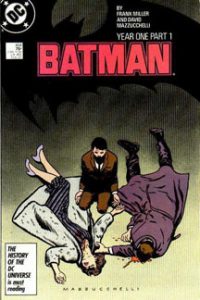This is part of a series where I look back at various works of “Batman” lore from the perspective of a heretofore casual “Batman” fan who enjoys the current TV series, “Gotham.”
Just as “The Dark Knight Returns” is considered the definitive late-career Batman story, “Batman: Year One” (1987) is hailed as the definitive early career Batman story. Remarkably, they were both written by Frank Miller, and within a year’s time. (And they’re both SET in the mid-Eighties, which requires a reader to understand the comic-book principles of multiverses and floating timelines.) But while “Returns” trod all-new ground, “Year One” trod ground that was already covered: Batman’s origin story, as told in “Detective Comics” No. 33 (1939) and “Batman” No. 27 (1948).
Although one could go down a rabbit hole examining alterations to the lore between the Golden Age and Silver Age, suffice it to say that DC didn’t want to alter Batman’s origin much for the Copper Age, even as it updated the origins of Superman and Wonder Woman (Wait, so they got new origins?! That’s another side trip I’ll avoid for now.).

“Batman: Year One” (1987)
DC, “Batman” Issues 404-407
Writer: Frank Miller
Artists: David Mazzucchelli (pencils, inks), Richmond Lewis (colors)
As DC editor Denny O’Neil (also a great Bat-writer for “Legends of the Dark Knight,” which added to the lore established by “Year One”) explains in the introduction to the “Year One” trade paperback: “The writers and artists had quick and clear ideas of how to update Superman and Wonder Woman, but Batman was a problem. He was fine just as he was. The origin that Bob Kane and Bill Finger created in 1939 was a perfect explanation of how and why Batman came to be. … But it might be improved. It could be given depth, complexity, a wider context. Details could be added to give it focus and credibility.”
The definitive Batman origin story
For a layperson like me who isn’t ready to explore multiverses or retcons just yet, “Year One” is the definitive Batman comic origin story. As we enter the tale, some foundational elements are in place: Bruce’s parents were killed when he was 8, Alfred is Batman’s only ally and the only one who knows his secret identity, and there’s a cave under Wayne Manor that’s home to numerous bats. But other than that, Miller is starting fresh.
As much an origin story for James Gordon as it is for Batman, “Year One” explains how the pair become allies in the fight against crime – particularly within the corrupt-to-its-core Gotham Police Department. To emphasize the fact that it starts from scratch, Batman arrives in Gotham at age 25 after a 12-year absence (I imagine he was training in martial arts overseas, a la “Batman Begins”). Gordon, formerly a cop in Chicago and about a decade older than Bruce, arrives to start his new post as a lieutenant in the GCPD.

The title comes from the fact that the four-issue story (originally published in “Batman” 404-407) takes place over the course of a calendar year. It has some gaps that allow for future stories, including several in “Legends of the Dark Knight” (which launched in 1989) that became colloquially known as Year One stories.
But it’s thematically tight. It illustrates the bond between Gordon and Batman despite the fact that they barely meet in this first year of Bats’ exploits. (“Gotham” is similarly spirited, but it takes place before Bruce becomes Batman, and the pair do occasionally interact.) On Nov. 3, on the book’s second-to-last panel, Bruce saves Gordon’s infant son and hands him back to his father, who has lost his glasses and therefore can’t see Bruce clearly.
Batman can’t do it alone
Paralleling Bruce’s realization that Gordon could be an ally (page 66: “I need an ally … an inside man. I need Jim Gordon. On my side.”) is Gordon’s realization that black-and-white cop-and-criminal rules – which presumably worked OK in the Windy City — don’t apply in Gotham.
On the final panel of Chapter Three, he’s kept awake by thoughts running through his head in Miller’s poetic noir style: “He’s a criminal. I’m a cop. It’s that simple. But – but I’m a cop in a city where the mayor and the commissioner of police use cops as hired killers. … He saved that old woman. … He saved that cat. … He even paid for that suit. … The hunk of metal in my hands is heavier than ever.”
David Mazzucchelli’s art and Richmond Lewis’ colors are delicious. A particularly illustrative series of panels comes at the start of Chapter Two, when Gordon drives through the pouring rain to get to a hostage standoff so he can take charge. The richness of the details – the way it makes Gotham City live and breathe – reminds me of the early Eastman/Laird work on “Teenage Mutant Ninja Turtles” during this same period, except E&L embellished their work with duo-tones, not color.
Among Lewis’ most striking use of color is the twilight blue sky on page 84 of the trade paperback, as Batman sweeps through the evening on his Batwing. I like how different sequences are marked by different color schemes; for instance, the SWAT team’s attack on Batman bridging Chapters Two and Three is told in reds and oranges.
Humorless, but not as grim as ‘Returns’
As he drives through the rain, Gordon knows that if “Branden and his lunatic SWAT team” have charge of the situation, people will die and property will be destroyed. Like “Returns,” “Year One” is timeless, but daring for its time: In the former, the bad guys are America; here, it’s an entire American police department, all the way up to Commissioner Loeb. (Well, almost. Sarah Essen, with whom Gordon has a brief affair, is a good cop. Interestingly, Gordon’s wife in “Returns” is named Sarah. Is she the same person?)
And while the militarization of police – including many stories of SWAT teams being used for marijuana raids – became mainstream news in the 21st century, the War on Drugs dates back to the 1970s, and Miller was well aware of the unsavory details that didn’t regularly make the evening news. The most striking lines in “Year One” come from the chatter of the SWAT members — scouring a building for Batman, dismissing a corpse as “just an old wino.”
“Year One” is seriously violent and largely humorless, but it is much less grim than “Returns.” Yes, Gordon and Bruce are outnumbered, but they aren’t alone. Essen is a good cop. Harvey Dent is a good prosecuting attorney. Alfred is a valuable ally.
Catwoman also introduced
And then there’s Catwoman, who is intrigued by Batman from a distance, although – as with Batman and Gordon – they barely cross paths: Batman is spying on the Roman crime family at the same time Catwoman is stealing from them, so they trip over each other’s missions. Controversially, Selina Kyle is portrayed as a prostitute in “Year One,” which differs from her previous origin stories, but it’s not surprising from the man who would go on to create “Sin City” (that now-famous title, in which a stripper is among the main characters, launched in 1991).
If Selina works as a prostitute, it would perhaps smooth out the relationship between Bruce and Selina in the sense that Batman is probably not interested in going after victimless crime. However, Miller also reveals that Selina is a cat burglar, too, and burglary does have victims. Further graying up the gray area, though, we only see her stealing from a crime family.
She also takes care of more than a dozen cats and a young, somewhat whiny fellow prostitute named Holly. (That last point might have influenced “Gotham,” where Selina looks after Ivy Pepper, a fellow dweller of the city’s streets and abandoned buildings.) Miller puts the pieces in place for Bats’ and Cats’ famously on-again, off-again relationship, where their ideals sometimes overlap and sometimes clash.
Unlike “Dark Knight Returns” – which I appreciate as a work of art but don’t want to wallow in – “Year One” hooks me. It makes me want to read “Year Two” and “Year Three.” And the previous eras’ Batman origins to compare and contrast. And more Year One stories like “Catwoman: Year One” and “Batgirl: Year One.” And more Batman tales from within that first year.

